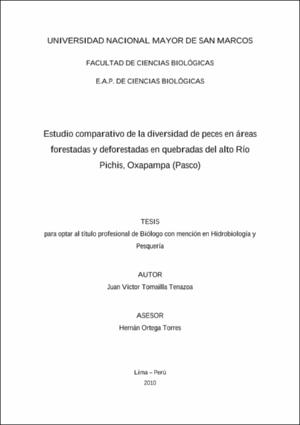Mostrar el registro sencillo del ítem
Estudio comparativo de la diversidad de peces en áreas forestadas y deforestadas en quebradas del alto Río Pichis, Oxapampa (Pasco)
| dc.contributor.advisor | Ortega Torres, Teófilo Hernán | |
| dc.contributor.author | Tomailla Tenazoa, Juan Víctor | |
| dc.date.accessioned | 2013-08-20T20:49:02Z | |
| dc.date.available | 2013-08-20T20:49:02Z | |
| dc.date.issued | 2010 | |
| dc.identifier.uri | https://hdl.handle.net/20.500.12672/891 | |
| dc.description.abstract | Las áreas deforestadas influyen sobre el clima, sistema hídrico y en el caudal de los ríos, además la erosión por la pérdida de la cobertura vegetal, ocasiona mayor carga de sedimentos en los ríos originan inundaciones más acentuadas en época lluviosa y niveles más bajos en época seca. También, la deforestación de zonas ribereñas influye sobre el número y tipo de organismos que habitan en los arroyos adyacentes, sin embargo, existe poca información. Con la finalidad de comparar la diversidad de peces en áreas naturales y deforestadas se realizó un estudio en tres quebradas del alto Río Pichis, Oxapampa, Pasco, con dos estaciones por quebrada (con y sin vegetación ribereña). Se realizaron dos muestreos: octubre 2005 y mayo 2006. Se registraron parámetros físico-químicos y características de hábitat, fotografías y se realizó pesca con redes de arrastre hacia la orilla. Se capturaron en total 3653 peces, provenientes de 12 muestras y seis estaciones de muestreo. Se identificaron 40 especies, en 12 familias y cinco órdenes. La mayor abundancia fue registrada en las estaciones deforestadas al igual que los mayores registros de riqueza. La diversidad no mostró variaciones marcadas entre los dos tipos de estaciones. El orden Characiformes fue el más abundante y registró la mayor riqueza de peces en todas las estaciones, destacando la familia Characidae. Los gráficos de la ordenación NMDS y los dendogramas formulados a partir de los índices de Similitud de Bray-Curtis, muestran una mayor similitud de cada tipo de hábitat que entre ellos. El mayor número de peces y especies en los tramos evaluados de los lugares deforestados con bancos de herbáceas en las orillas podría deberse a la presencia de una mayor heterogeneidad de hábitats, asimismo la remoción de bosque ribereño produjo algunos cambios en la estructura comunitaria de peces. -- Palabras Claves: Amazonía peruana, estructura comunitaria, diversidad de especies, deforestación ribereña, peces | |
| dc.description.abstract | -- The deforested areas could modified the weather and the hydrographic system, and the quantity of water of the rivers, then follow the increase of the erosion as result of the vegetation removed and showing a major amount of the sediments in the rivers producing higher flooding during the rainy season and lowest levels during the dry season. Besides, the deforestation of the reverie zones has direct effect on the number and type of the organisms which are living along the related streams. However, there is a lack of quantitative information about the deforestation related to the aquatic fauna affected. With the objective to compare the fish diversity in natural areas and deforested areas one study was carried out along the three streams at the Alto Río Pichis, Oxapampa, Pasco, sampling in two stations by stream (with or without reverie vegetation). The sampling was made in: october 2005 and may 2006. It was recorded the phisic-chemical parameters and habitat characteristics, photography and the fishing was made with seines to the borders. It was collected 3653 fishes, from 12 samples and six sampling stations. Were identified 40 species, belonging 12 families and five orders. The major abundant was recorded at the deforested stations and the same the higher values of richness. The diversity did not show remarked variations between two kinds of stations. The order Characiforms was the most abundant and recorded the higher value of richness en every station, especially Characidae family. The graphics of ordination NMDS and dendograms formulated since the Similarity of Bray-Curtis index, show us a major similarity of every kind of habitat than between both of them. The major number of fishes and species in the evaluated sectors of deforested areas with grasses banks could be related to a major heterogeneity of habitats, it selves to shore wood remotion made several changes in the community structure of fishes. -- Key Words: Peruvian Amazon, community structure, fishes, riparian deforestation, species diversity. | |
| dc.description.uri | Tesis | |
| dc.language.iso | spa | |
| dc.publisher | Universidad Nacional Mayor de San Marcos | |
| dc.rights | info:eu-repo/semantics/openAccess | |
| dc.rights.uri | https://creativecommons.org/licenses/by-nc-sa/4.0/ | |
| dc.source | Universidad Nacional Mayor de San Marcos | |
| dc.source | Repositorio de Tesis - UNMSM | |
| dc.subject | Comunidades de peces - Aspectos ambientales - Perú - Pichis, Río | |
| dc.subject | Peces - Hábitat - Perú - Pichis, Río | |
| dc.subject | Evaluación biológica de la calidad del agua - Perú - Pichis, Río | |
| dc.title | Estudio comparativo de la diversidad de peces en áreas forestadas y deforestadas en quebradas del alto Río Pichis, Oxapampa (Pasco) | |
| dc.type | info:eu-repo/semantics/bachelorThesis | |
| thesis.degree.name | Biólogo con mención en Hidrobiología y Pesquería | |
| thesis.degree.grantor | Universidad Nacional Mayor de San Marcos. Facultad de Ciencias Biológicas. Escuela Académico Profesional de Ciencias Biológicas | |
| thesis.degree.discipline | Ciencias Biológicas | |
| dc.subject.ocde | https://purl.org/pe-repo/ocde/ford#1.06.00 | |
| dc.publisher.country | PE | |
| renati.advisor.dni | 10330989 | |
| renati.advisor.orcid | https://orcid.org/0000-0002-4396-2598 | |
| renati.level | https://purl.org/pe-repo/renati/level#tituloProfesional | |
| renati.type | https://purl.org/pe-repo/renati/type#tesis |


